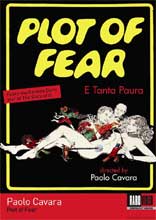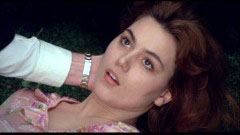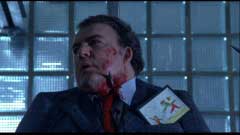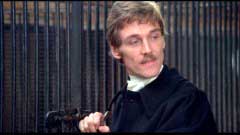 PLOT
OF FEAR (1976)
PLOT
OF FEAR (1976)Director: Paolo Cavara
Raro Video USA
 PLOT
OF FEAR (1976)
PLOT
OF FEAR (1976)When two of the founding members of “The Wildlife Friends” club – or “The Fauna Lovers” on the Italian track – are brutally murdered and pages illustrating characters from the fairytale “Shock-headed Peter” are left at the scenes of the crime, Detective Gaspare Lomenzo (Michele Placido, OEDIPUS ORCA) is on the case (much to the consternation of his harried chief [Tom Skerritt, ALIEN]). His assistant (one of the film’s scenarists, Enrico Oldoni) tells him that he recalls a scandal involving the club four or five years ago, but the file on the case is empty and its disgraced investigating officer Del Re mysteriously disappeared. Since the club met at the Villa Hoffmann, Lomenzo is sure the incident is related to the murders (the fairytale’s author was, after all, E.T.A. Hoffmann).

He learns that the villa’s owner Hoffmann (John Steiner, TENEBRAE), who collected wild animals and maintained a menagerie at his estate (in addition to capturing and selling animals to circuses and zoos worldwide), sold off his animals and went to Amsterdam where he died. Lomenzo’s model girlfriend Ruth (Mary Ruth League, THE DIVINE NYMPH) introduces Lomenzo to model/prostitute Jeanne (Corinne Clery, MOONRAKER) who takes him to the Villa Hoffmann and tells him the details of the scandal: the wildlife society was really a front for an elite sex club, and a prostitute named Rosa (Sarah Ceccarini, NAZI LOVE CAMP 27) died of shock when some drunken revelers tried to drag her into a tiger’s cage. The participants and witnesses told Rosa’s pimp Augustino (Claudio Zucchet, THE BEAST IN SPACE) and the police that Rosa died of alcohol poisoning in the villa’s lounge. When two more members of The Wildlife Friends are killed (including a politician who is shot on the air while being interviewed about the case), the remaining members – including mama’s boy Angelo Scanavini (Quinto Parmeggiani, THE WEEKEND MURDERS) – start to get nervous and consult Mabusian private detective Peter Struwwel (Eli Wallach, THE GODFATHER PART III). Struwwel leaks some selected information to Lomenzo, who is searching for the recently released Augustino; however, the pimp’s capture only gives a false sense of relief to the next victims.
 PLOT
OF FEAR was the second giallo of former MONDO CANE documentarian Paolo Cavara
(the first being BLACK BELLY OF THE TARANTULA), and it seems informed by Argento’s
oeuvre thus far. Scripted by Oldoni and Fellini’s regular collaborator
Bernardino Zapponi – who also co-scripted DEEP RED – the film has
a strain of black humor as well as several comic relief supporting characters
familiar from Argento’s “animal trilogy” (and largely absent
from Sergio Martino’s competing entries). MAN FROM DEEP RIVER composer
Daniele Patucchi’s score also occasionally references early Argento with
some Morricone-esque la-la vocalizing, as well as DEEP RED with some sub-Goblin
electric guitar. Although there is one nasty moment where a victim is burnt
alive, the film’s exploitation elements seem half-hearted. Placido’s
sex scenes with League and Clery last only long enough for the requisite topless
shots before cutting back to the plot (the many prostitutes in flashback and
the present remain clothed), and only one death exhibits anything along the
lines of Argento’s stylistic editing and photographic verve (the film
was shot by FOUR FLIES ON GREY VELVET cinematographer Franco Di Giacomo [using
the same camera operator [Giuseppe Lanci] and assistant [Gianfranco Transunto]).
Indeed, much of the film's style comes less from the camera angles and lighting
than from the set design (by Franco Fumagalli [THE HORRIBLE DR. HICHCOCK]) –
particularly Struwwel’s office complex – the Fendi wardrobe showcased
by Clery and some of the other actresses, and the foggy environs of the Villa
Hoffmann’s grounds and the Swiss border where Scanavini’s sports
car suffers a mysterious breakdown. The Milanese setting is effectively gritty
(the contrast of the villa’s misty settings suggests that it belongs to
an alternate world where the Wildlife Friends can shed their respectable facades),
and some jokes are made about Lomenzo’s Southern upbringing (Southern
Italy, that is; Naples to be exact) and his preferences for hearty pasta over
his girlfriend’s macrobiotic cooking. Raro’s cover synopsis compares
the sex club angle to EYES WIDE SHUT, but the aesthetics of the sequences have
more in common with Pasolini’s SALO – which the director’s
son also cites as a thematic influence in his interview – (although nowhere
near as graphic); the script, however, fails to delineate most of the victims-to-be
other than the obvious “perverts hiding behind respectable facades”
characterization. The scenario also ties only one of the killings in with Hoffmann’s
occasionally grisly fairytale. In spite of all this, the story is unpredictable,
compelling, and the twists-upon-twists of the finale are neat (if a bit far-fetched)
rather than tiresome.
PLOT
OF FEAR was the second giallo of former MONDO CANE documentarian Paolo Cavara
(the first being BLACK BELLY OF THE TARANTULA), and it seems informed by Argento’s
oeuvre thus far. Scripted by Oldoni and Fellini’s regular collaborator
Bernardino Zapponi – who also co-scripted DEEP RED – the film has
a strain of black humor as well as several comic relief supporting characters
familiar from Argento’s “animal trilogy” (and largely absent
from Sergio Martino’s competing entries). MAN FROM DEEP RIVER composer
Daniele Patucchi’s score also occasionally references early Argento with
some Morricone-esque la-la vocalizing, as well as DEEP RED with some sub-Goblin
electric guitar. Although there is one nasty moment where a victim is burnt
alive, the film’s exploitation elements seem half-hearted. Placido’s
sex scenes with League and Clery last only long enough for the requisite topless
shots before cutting back to the plot (the many prostitutes in flashback and
the present remain clothed), and only one death exhibits anything along the
lines of Argento’s stylistic editing and photographic verve (the film
was shot by FOUR FLIES ON GREY VELVET cinematographer Franco Di Giacomo [using
the same camera operator [Giuseppe Lanci] and assistant [Gianfranco Transunto]).
Indeed, much of the film's style comes less from the camera angles and lighting
than from the set design (by Franco Fumagalli [THE HORRIBLE DR. HICHCOCK]) –
particularly Struwwel’s office complex – the Fendi wardrobe showcased
by Clery and some of the other actresses, and the foggy environs of the Villa
Hoffmann’s grounds and the Swiss border where Scanavini’s sports
car suffers a mysterious breakdown. The Milanese setting is effectively gritty
(the contrast of the villa’s misty settings suggests that it belongs to
an alternate world where the Wildlife Friends can shed their respectable facades),
and some jokes are made about Lomenzo’s Southern upbringing (Southern
Italy, that is; Naples to be exact) and his preferences for hearty pasta over
his girlfriend’s macrobiotic cooking. Raro’s cover synopsis compares
the sex club angle to EYES WIDE SHUT, but the aesthetics of the sequences have
more in common with Pasolini’s SALO – which the director’s
son also cites as a thematic influence in his interview – (although nowhere
near as graphic); the script, however, fails to delineate most of the victims-to-be
other than the obvious “perverts hiding behind respectable facades”
characterization. The scenario also ties only one of the killings in with Hoffmann’s
occasionally grisly fairytale. In spite of all this, the story is unpredictable,
compelling, and the twists-upon-twists of the finale are neat (if a bit far-fetched)
rather than tiresome.

Future Bond girl Clery – in her first film following THE STORY OF O – is mostly window-dressing here, modeling high fashion (and blue jeans) both as a model and a character, and Jeanne’s relationship with Lomenzo seems obligatory (see Pasquale Festa Campanile’s HITCH-HIKE for a more satisfying Clery Italian exploitation performance). Placido’s detective is scripted to be quirky (he makes spaghetti by boiling/draining noodles, squirting them with a tube of tomato paste, and a dollop of grated parmesan cheese), but Placido plays him sour with the occasional outburst of bellowing. Placido later had a supporting role in Carlo Lizzani’s NIGHT PORTER-esque KLEINHOFF HOTEL in which Clery misses a flight to London and checks into a Berlin hotel where she stayed as a student years before and has a tempestuous affair with possible terrorist Bruce Robinson (later the writer/director of WITHNAIL AND I). A pre-ALIEN Skerritt actually has little screen time; presumably his role in Duccio Tessari’s LA MADAMA the same year (and his only other Italian film credit that decade) made the trip to Italy worth the while. Although Wallach – no stranger to Italian film production, having appeared in Leone’s THE GOOD, THE BAD, AND THE UGLY as well as a couple more westerns and crime films – also has a seemingly throwaway role early on, he becomes a more central character in the film’s third act. Steiner cuts a fine figure as Hoffmann, doing his usual jaded, impassive, quasi-aristocratic persona. Other than Steiner, the cast – which also includes prolific French actor Jacques Herlin (THE WHIP AND THE BODY) – is mostly atypical of a giallo film, suggesting that Cavara and producers Ermanno Curti (YOUNG, VIOLENT, DANGEROUS) and Guy Luongo (THE AFRICAN DEAL) were aiming for something more mainstream than the other Argento-inspired gialli flooding the market (although Zucchet will look familiar to diehard fans of Andrea Bianchi’s BURIAL GROUND as the none-too-bright butler, but would later appear with Clery in Massimo Pirri’s drug movie THE TUNNEL).
 Raro
Video first released PLOT OF FEAR on DVD in Italy in a single-layer, non-anamorphic
transfer with English and Italian mono audio options with optional English subtitles.
The only extras were the usual director’s biography and filmography in
Italian. Raro Video USA’s dual-layer release features a new dual-layer
HD-mastered 1.85:1 widescreen transfer, and is definitely an improvement over
the old transfer. The image is slightly darker, but the colors are richer and
the skintones look more realistic (the Italian edition was brighter but also
paler). English and Italian Dolby Digital mono audio options are reasonably
clean and Patucchi’s music comes through nicely. I only noticed one spelling
error in the optional English subtitles; although they contain a couple of untranslated
terms like “carabinieri” and the Italian word used for some variation
of tram driver. Late in the film, a character addresses Lomenzo as dottore (doctor),
which is an honorific used here to sarcastically comment on the police detective’s
educated, middle-class background. The English subtitles use the English title
for the Hoffmann book “Shock-headed Peter”; the original German
title to the Hoffmann fairytale would be a spoiler to a suspect’s identity,
so the Italian title of the story is not used in the English dub until late
in the film (but things are not as simple as the clue suggests).
Raro
Video first released PLOT OF FEAR on DVD in Italy in a single-layer, non-anamorphic
transfer with English and Italian mono audio options with optional English subtitles.
The only extras were the usual director’s biography and filmography in
Italian. Raro Video USA’s dual-layer release features a new dual-layer
HD-mastered 1.85:1 widescreen transfer, and is definitely an improvement over
the old transfer. The image is slightly darker, but the colors are richer and
the skintones look more realistic (the Italian edition was brighter but also
paler). English and Italian Dolby Digital mono audio options are reasonably
clean and Patucchi’s music comes through nicely. I only noticed one spelling
error in the optional English subtitles; although they contain a couple of untranslated
terms like “carabinieri” and the Italian word used for some variation
of tram driver. Late in the film, a character addresses Lomenzo as dottore (doctor),
which is an honorific used here to sarcastically comment on the police detective’s
educated, middle-class background. The English subtitles use the English title
for the Hoffmann book “Shock-headed Peter”; the original German
title to the Hoffmann fairytale would be a spoiler to a suspect’s identity,
so the Italian title of the story is not used in the English dub until late
in the film (but things are not as simple as the clue suggests).
 The
U.S. disc is not just an anamorphic upgrade with a beefed-up bitrate, since it
features a handful of newly produced extras. First up is an interview with screenwriter
Enrico Oldoni
The
U.S. disc is not just an anamorphic upgrade with a beefed-up bitrate, since it
features a handful of newly produced extras. First up is an interview with screenwriter
Enrico Oldoni Finally,
there is a new interview with actor Michele Placido (17:09), in which the actor
– coming from a theatrical background – admits to having been a
bit of a snob towards thrillers (although he did like Argento’s films)
and that he viewed Cavara’s BLACK BELLY OF THE TARANTULA before agreeing
to work with him on PLOT OF FEAR. Placido admits to not having seen the movie
recently, so his memories of the shoot are a bit hazy and the interviewer keeps
his questions general. He recalls that Clery was a bit wary of his advances
while in character, thinking him too hot-blooded. He credits Oldoni more than
Cavara with helping him prepare for the part (including table readings with
Skerrit and Wallach). The camerawork on the interview is annoyingly amateurish,
and the interview itself is a bit unfocused; however, it’s nice to know
that the actor considers the film a serious work rather than some B picture
made towards the start of his film career. Raro Video USA’s disc of YOUNG,
VIOLENT, DANGEROUS promised a PDF liner notes booklet in lieu of their usual
glossy inserts, and its menu included instructions on how to access it; however,
the PDF file was missing from the disc. PLOT OF FEAR boasts of a PDF booklet
with liner notes by Fangoria’s Chris Alexander, and it has indeed been
included. Fortunately, Raro Video have maintained their red-and-black color
scheme, page size, and layout for this digital booklet rather than going the
cheap route and just converting a Word .doc to PDF. (Eric
Cotenas)
Finally,
there is a new interview with actor Michele Placido (17:09), in which the actor
– coming from a theatrical background – admits to having been a
bit of a snob towards thrillers (although he did like Argento’s films)
and that he viewed Cavara’s BLACK BELLY OF THE TARANTULA before agreeing
to work with him on PLOT OF FEAR. Placido admits to not having seen the movie
recently, so his memories of the shoot are a bit hazy and the interviewer keeps
his questions general. He recalls that Clery was a bit wary of his advances
while in character, thinking him too hot-blooded. He credits Oldoni more than
Cavara with helping him prepare for the part (including table readings with
Skerrit and Wallach). The camerawork on the interview is annoyingly amateurish,
and the interview itself is a bit unfocused; however, it’s nice to know
that the actor considers the film a serious work rather than some B picture
made towards the start of his film career. Raro Video USA’s disc of YOUNG,
VIOLENT, DANGEROUS promised a PDF liner notes booklet in lieu of their usual
glossy inserts, and its menu included instructions on how to access it; however,
the PDF file was missing from the disc. PLOT OF FEAR boasts of a PDF booklet
with liner notes by Fangoria’s Chris Alexander, and it has indeed been
included. Fortunately, Raro Video have maintained their red-and-black color
scheme, page size, and layout for this digital booklet rather than going the
cheap route and just converting a Word .doc to PDF. (Eric
Cotenas)